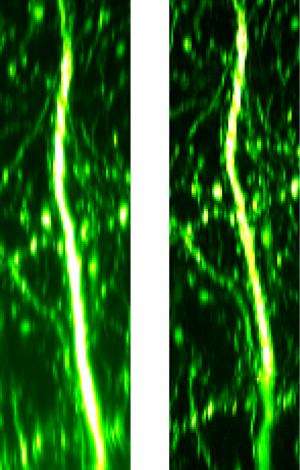Advances in nonlinear microscopy allow researchers to take detailed images deep below the surface of samples

Optical microscopes, also known as light microscopes, provide detailed images of sample surfaces, but their use in looking below the surface is limited. A workaround is to look for signals given off by a sample of interest when it interacts simultaneously with two particles of light (or photons), using a technique called nonlinear spectroscopy. Now, Keisuke Isobe and colleagues at the RIKEN Advanced Science Institute, Wako, have shown how nonlinear techniques can be used to peer even more deeply into a sample.
The most common type of optical microscope is a linear instrument. This means that the atoms of a sample of interest interact with only one photon at a time. As common and productive as it is, however, this linear approach has limitations that are surpassed by nonlinear microscopy. For example, a small volume of the sample can be isolated under a nonlinear microscope by illuminating it with two intersecting, non-parallel light rays. Background noise can be easily filtered out. The resulting high signal-to-noise ratio allows the operator to take detailed images, including from below the sample surface. However, when depths become particularly large, noise increases to the point that even nonlinear images begin to lack clarity.
Isobe and colleagues demonstrated a technique that can decrease background noise by a factor of 100 and can increase imaging depths by a factor of two over traditional nonlinear approaches. These traditional approaches maximize the volume of overlap of two different pulses of light at some point of interest inside the sample. Instead, the Japan-based team used beam-pointing optics to periodically modulate this spatial overlap. The signal produced in the center of the volume of interest was modulated at twice the overlap modulation frequency. Isobe says that the signals produced away from the center were modulated at lower frequencies.
By filtering out these lower-frequency signals, the researchers succeeded in greatly reducing background noise. When Isobe and colleagues applied this technique to the imaging of mouse brains, spatial overlap modulation allowed them to resolve structures at depths of 240 micrometers, where traditional nonlinear microscopy began to fail. The overlap modulation also significantly increased resolution.
Isobe says this kind of visualization can be used to track signal transmission down axons in the brain, and can be readily implemented into existing nonlinear microscopes. "We also plan to investigate its use for medical interventions," he says, "like laser surgery."
More information: Isobe, K., Kawano, H., Takeda, T., Suda, A., Kumagai, A., Mizuno, H., Miyawaki, A. & Midorikawa, K. Background-free deep imaging by spatial overlap modulation nonlinear optical microscopy. Biomedical Optics Express 3, 1594–1608 (2012). dx.doi.org/10.1364/BOE.3.001594
Journal information: Biomedical Optics Express
Provided by RIKEN


















